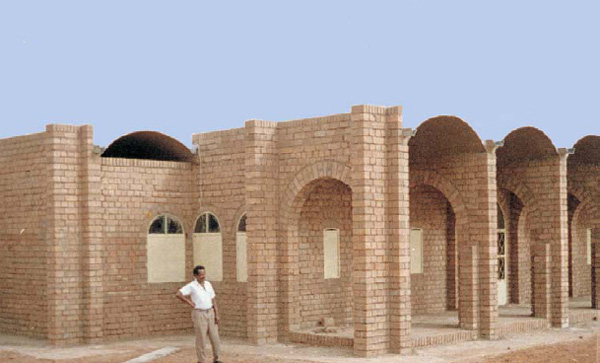
I’ve put together a brief list of compressed earth block (CEB) technical documents.
New Mexico Compressed Earth Block Building Code
UNESCO Compressed Stabilized Earth Block Manufacture in Sudan
[Try this site if the above link doesn’t work: http://www.doc88.com/p-902850587112.html]
Earth as a construction material has been used for thousands of years by civilizations all over the world. Many different techniques have been developed, the methods used vary according to the local climate and environment as well as local traditions and customs. As a modest estimate it is thought that as many as 30% of the world’s population live in a home constructed in earth.
Earth construction is very cost effective, energy efficient (excellent thermal
properties and low energy input required for production), environmentally friendly, and safe, qualities which are particularly relevant and important with the ever growing need for increased awareness to reduce energy consumption world wide.
CRAterre Compressed Earth Block Standards
New Zealand 4299 Earth Buildings Not Requiring a Specific Design is not a “cook book” as such, but is essential for earth building designers. It allows the design of relatively simple earth buildings that fall within its limits without requiring specialist engineering. There are many building details given, and bracing values for various types of earth walls from unreinforced through to totally reinforced earth walls, bond beam sizes and fixings, foundations, window jamb, head and sill details etc.
New Zealand Earth Building Standard
In the 1980’s growing interest in more environmentally friendly and sustainable buildings resulted in increasing public acceptance of earth housing. People wanting to use natural building materials were leaders in the recent upsurge in earth building in New Zealand. Subsequently many small earth homes and large executive style houses have been constructed or are currently being constructed in New Zealand. It is estimated that well over 100 earth buildings have been built during the past 10 years in New Zealand and this has necessitated builders and engineers liaising in detail with building authorities to establish he viability of various earth building techniques.
Development of New Performance Based Standards for Earth Building (2007)
As the number of houses built from earth increases in New Zealand so has the need for standards. The background, development and some key technical issues are outlined. Three New Zealand Standards for earth building have been developed using limit state design principles. The standards are NZS 4297 Engineering Design of Earth Buildings, NZS 4298 Materials and Workmanship for Earth Buildings and NZS 4297 Earth Buildings Not Requiring Specific Design. The standards cover adobe (sun dried brick), rammed earth and pressed brick construction including reinforced and unreinforced walls.
Compressed Earth Building Blocks for Affordable Housing
This project explored the possibility of using local soils for making compressed earth blocks for the construction of affordable residential buildings. The blocks were made with a block press that delivers a high compressive effort. Blocks were also made from soils with 5% of ordinary Portland cement and kenaf fiber, an agricultural fiber, respectively. Mortar and plaster were made from clayey soil and a blend of clay and cement. The blocks were tested for compressive strength and modulus of rupture. The results met code requirements for compressed earth block one-story housing construction. The durability of the blocks was also examined.
Soil has been widely used for thousands of years and still is today. It is an effective and an economic form for housing construction and according to the United Nations, about a third of the world’s population live in earthen structures today. Compressed earth blocks are economically and effectively made with compressed earth block machines. Soil is the most abundant and inexpensive resource. Compressed earth blocks are safe alternatives to masonry. They are low cost and can be designed to be earthquake resistant. Compressed earth blocks are non-toxic, are sound resistant, fire-resistant, and insect-resistant. The compression strength of a soil can be increased by chemical stabilization. Suitable soil on a building site eliminates transportation costs. Compressed earth blocks are inexpensive, strong, made with locally available materials and are dimensionally uniform. Workers with little prior building knowledge and experience can be used for the wall construction. The mass of the compressed earth block walls makes the walls energy efficient systems. Little energy is needed for their production compared to other wall systems and soil is an environmentally friendly material.
Compressed Earth Block Building Systems – An Experience in Undergraduate Research
Some standard tests were conducted on local soils and the soils were used to make compressed earth blocks. The basic concept of this project was to explore the possibility of using local soils to make compressed earth blocks for the construction of residential buildings. This paper reports the results of a study done using two undergraduate students to study the properties of local soil materials and making compressed earth blocks with a block press that delivers a high compressive effort. The blocks were tested for dimensional stability, compressive strength and modulus of rupture. The compressed earth blocks made gave an average dry density of 108 pounds per cubic feet (pcf), an average modulus of rupture of 47.56 psi and an average compressive strength of 41 psi. at 16 days and 56.51 psi at 28 days. A method of wall construction using the compressed earth blocks was demonstrated. The durability of the blocks when subjected to the rain and snow was also examined.

Happy to see your compressed Earth Block (CEB) house designs.
Am happy to get mails and pictures of earth work building as it gives me courage to look for money so that i can construct an Eco lodge
Owen
Haven’t seen a post from you in a while. I didn’t know if I had technical issues. Glad to know you are still out and about.
Good to hear from you. My yahoo account got hacked in case you didn’t notice. My new email is at the top of the page. How are things going?